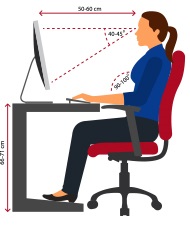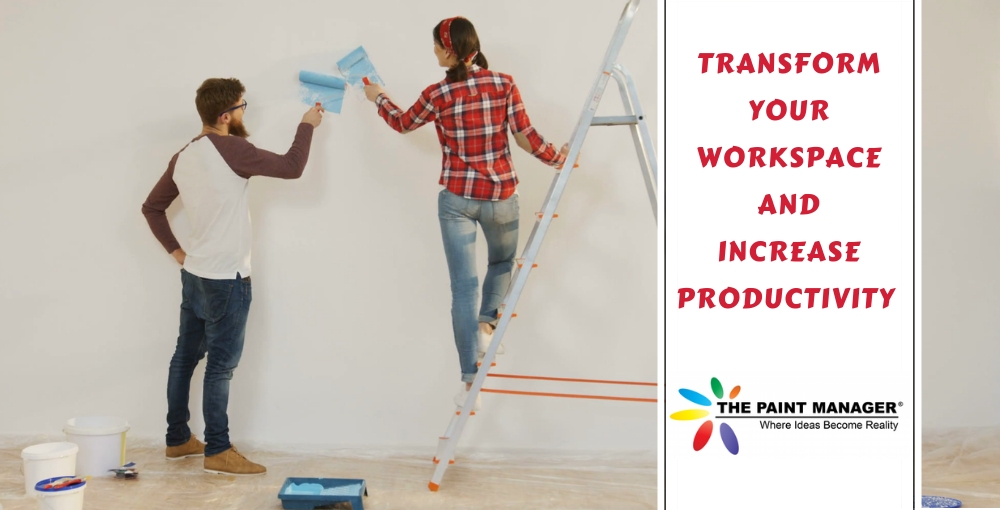We spend most of our day at work, so it stands to reason that our office environment has a big impact on our feeling of well-being – and, as a result, our productivity. So whether you’re a business owner who wants happier, more productive employees – or an entrepreneur working from your home office – our pros at The Paint Manager offer the following budget-friendly tips to brighten up and spruce up your workspace!
Is this really worth the investment?
Yes! According to Lifehack, a pleasant office environment can increase productivity by up to 20%, and can even improve employee retention. If you work at home, transforming your office from a spare room with a desk and laptop to a functional dedicated space produces a more professional mindset that can ultimately win you more business.
Best paint colors for productivity
Because we are, after all, The Paint Manager, we know color has an important role to play. For example, you may be surprised to learn that the interior wall colors that create a peaceful haven for your home aren’t necessarily optimum choices for the workplace. Office colors need to set a calming mood, yet be stimulating enough to encourage alertness – like the perfect balance when you’ve had just enough coffee, but not too much.
For example, it is well-known that bright colors are associated with energy. But this might not be the ideal choice for your office. A study by the University of Rochester found that reactions become both faster and more forceful when people see the color red, yet the boost is short-lived. Though the color is ideal for some environments, it isn’t suited to inspire and sustain productivity in an office. However, if you have a home office (or a gray cubicle) and like red, use it in accessories to provide an energizing pop of color.
So, what are the colors that can work best for your office? Our colleagues at Scott Brown Painting examine the effects of color on mood and productivity, and offer their recommendations. The article also makes an important distinction between choosing colors for a company workplace and a home office.
Colors and their accompanying effect are as follows.
Blue: Mind
The color blue stimulates the mind, leading to more productivity. The hues of the blue color palette are ideal for staying focused in repetitive industries. Accounting offices often use blue paint colors to increase productivity and keep their employees focused.
Red: Body
As mentioned, red evokes a sense of urgency, so for physical jobs like construction, red will stimulate their energy levels.
Yellow: Emotion
Yellow stimulates emotion, which makes it an ideal color for creative industries. It also evokes feelings of happiness and can brighten spirits.
Green: Balance
We may think of green as the color of money, and in a way it is. Green is all about balance, calmness, and reassurance. So if you work in the financial industry, green works well as your office color.
Top 10 colors to improve office productivity
Keeping all of the above in mind, here are the leading, proven colors to make office workers happier and more productive.
Off-white – This tone provides a clean, uplifting feeling without the stark, clinical feel that a true white can evoke, making it an excellent choice both for company and home offices.
Teal/light blue – As teal is a combination of blue and green, it can turn any workspace into a productivity machine. It’s important to be careful as not to have too much of one over the color. The brightness and intensity are also important for the desired effect.
Gray – A classic corporate office color, gray is offered with a caveat. Too dark a shade can produce the opposite effect, turning the mood drab and depressing. A touch of silver provides a touch of class with a more elegant, uplifting feeling.
Light blue – If you want to establish a calming, reassuring effect, you can’t go wrong with light blue. It’s a great choice for medical offices and other establishments in which the nature of the work is stressful.
Blue-gray – In the corporate world, blue-grays can feel clean and give a boost to a backdrop without being too moody.
Brown – This warm color works very well in a space that needs to feel powerful and strong. Use lighter or complementary colors for trim and accents to keep the mood from becoming too heavy.
Pastel Yellow – A good choice for a company in a creative industry, this uplifting color can be accented with white or brown shades. However, it can be off-putting to some, so if you’re looking for a little sunshine in the office, use it for an accent wall instead of the primary wall color.
Purple – Again, one of those colors it’s easy to go overboard with unless the paint is blended by a color specialist. Certainly not for every business, but lighter shades (like violet) are good for a hair salon or clothing boutique. It also can be effective for an accent wall.
Green – A wide range of shades can set the right mood for productivity in a wide range of workplaces. Rich greens lend an affluent tone to financial industry offices, while lime green is popular for advertising and other creative agencies.
Orange – Painting all four walls orange may be a little too much, but using it for an accent wall could be the perfect remedy for low-energy afternoons. Consider trim and surrounding colors, however, or the effect could be garish instead of invigorating.
Colors for the home office
Because your home office is, after all, part of your home, the advice for paint color is a little different. As Scott Brown Painting observes:
“If you can’t stand the color yellow there are not enough promises of a happy, creative workspace that will get you to change your mind. In some cases, people who work from a home office feel like keeping the wall colors neutral is best. They opt to add an accent wall or paint the trim a different color. Others prefer a revamped workspace without any correlation to the rest of the colors in the house. This helps them to focus on work and not get tempted by personal comfort.”
Finishing touches to consider
Many other factors combine to increase productivity in the company or home office.
Lighting – When we talk about productivity, it is important to focus on lighting in your office. Inadequate or bad lighting can strain your eyes, cause fatigue, headaches and irritability. Spaces that are dark can lead to depression. Whether you work from your home or work in an office, make sure that the lighting is good.
Room scents – Just as color affects your mood, so do scents. Aromatherapy is a holistic healing treatment that uses natural plant extracts to promote health and well-being. A wide variety of fragrances are available in such formats as diffusers, diffuser sticks and plug-in diffusers. Of course, choosing your preference is easier for your personal home office. Depending upon your company office space, you may be able to have a fragrance source that stays confined to your own work area. If you’re in charge of a company office, choose a non-specific fresh, clean scent.
Noise level – Some people have a challenge tuning out background sounds, such as nearby conversations – which can be unavoidable in a company setting. Noise canceling headphones are ideal for this situation. They also can help home office workers when neighbors are mowing the lawn, or negate loud household activities.
Ergonomics – Defined as the science of fitting a workplace to the user’s needs, ergonomics aims to increase efficiency and productivity and reduce discomfort. An understanding of ergonomics can prevent most workplace injuries by adjusting tools to the user, putting an emphasis on proper posture to reduce the impact of repetitive movements. Desks, chairs, monitors, keyboards and lighting all need to be assessed when creating a workspace, whether it is at a company office or home office.

Ergonomic Fundamentals include:
- The top of the monitor should be below or at eye level. Eyes should be 24-36 inches from the computer screen.
- Feet should be on a footrest or resting on the floor.
- A slightly reclined chair posture is best to reduce pressure on your spine and minimize lower back pain.
Finding the right painting contractor
Whether you’ve been charged with finding a painting contractor for your commercial office, or you’d just rather leave painting your home-sweet-home office to the pros, The Paint Manager has the experience, equipment and expertise for any size project. Contact us to learn more and schedule an appointment. We look forward to helping you create an office environment that will allow you to achieve your best!

